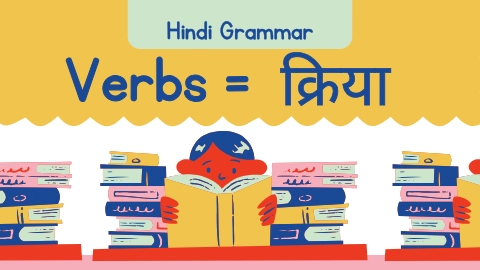I was —--------- Book. He —--------- to Seattle. Did any of these make sense to you? No, right? While you may assume some action is being done, you can’t be sure unless someone specifies.
This isn’t just the case in English Grammar, it is an integral part of Hindi grammar as well. And it is not just about the assumption of action, you can’t even structure a sentence in Hindi without Hindi verbs.
So let us take a look at this integral part of Hindi grammar.
- How to Structure Sentences in Hindi ?
- क्रिया के भेद
- 1. प्रयोग के आधार (on the basis of usage) on the basis of usage, there are two different types
- 2. रचना के आधार पर (on the basis of composition)
- मुख्य क्रिया (Main verbs)
- Examples
- प्रेरणार्थक क्रिया (Inspirational verbs)
- Examples
- संयुक्त क्रिया (Compound Verbs)
- Examples
- नामधातु क्रिया
- पूर्वकालिक क्रिया (Preterite verbs)
- Examples
- अनुकरणात्मक क्रिया (Imitative Verbs)
- Examples
- सहायक क्रिया (Auxillary Verb)
- Examples
- रंजक क्रिया
- सरल क्रिया (simple verb)
- Example
- नामिक क्रिया (Mixed kriya)
- Examples
- Hindi Verbs Exercise रिक्त स्थानों की पूर्ती उचित क्रियाओं से कीजिये। (Fill in the blanks)
- Beginner's Guide to Hindi Verbs - क्रिया क्या होते हैं?
- Conclusion
- FAQs
Just as in the English language, a verb is a word used to express some action(कार्य), feeling(भाव), or existence(अस्तित्व). It tells us something about the subject. Every action either happens or is done by someone.
How to Structure Sentences in Hindi ?


1. कर्ता (Karta)
The one who does the work is called कर्ता ( karta - doer)
2. धातु ( Dhatu)
The root form of a verb is called धातु (dhatu)
Example: भागता, भागा , भागना. In all these, भाग is the dhatu or root form of the verb.
क्रिया के भेद
Types of Hindi Verbs In Hindi, verbs can be divided into two different categories.
प्रयोग के आधार पर (on the basis of use)
रचना के आधार पर (on the basis of composition)
1. प्रयोग के आधार (on the basis of usage) on the basis of usage, there are two different types
सकर्मक क्रिया (Transitive verb)
अकर्मक क्रिया (Intransitive verb)
सकर्मक क्रिया (Transitive Verbs)
सकर्मक (transitive) means with or with action. The verb which has an effect on the action rather than on the doer is called सकर्मक क्रिया transitive verb.
Examples
मै ख़ुशी से हॅसता हूँ।
बच्चे जोरों से रो रहे हैं।
एलेक्स खाना खा रही है।
सकर्मक क्रिया के भेद (Types of transitive verbs)
There are two types of transitive verbs in Hindi
एककर्मक क्रिया
A verb that has only one action is called एककर्मक क्रिया।
द्विकर्मक क्रिया
A verb in which there are two actions is called दवीकर्मक क्रिया।
अकर्मक क्रिया (Intransitive Verbs)
अकर्मक क्रिया (Intransitive verb) means without action or without action. Actions which do not require action and the result of actions falls on the doer, are called अकर्मक क्रिया (intransitive verbs).
In other words, the verbs whose fruit and business are received by the doer are called अकर्मक क्रिया intransitive verbs.
Examples
वे हसते है।
बच्ची रो रही है।
एलेक्स खा रही है।
2. रचना के आधार पर (on the basis of composition)
There are 10 distinctions of verbs on the basis of the composition.
मुख्य क्रिया ( Main verbs)
प्रेरणार्थक क्रिया (Insprational verbs)
संयुक्त क्रिया (Compund Verbs)
नामधातु क्रिया
पूर्वकारक क्रिया (Anterior Verbs)
अनुकरणात्मक क्रिया (Imitative Verbs)
सहायक क्रिया (Auxillary Verb)
रंजक क्रिया
सरल क्रिया (simple verb)
नामिक क्रिया (mixed kriya) Let’s take a look at each of them.
Let’s take a look at each of them.
मुख्य क्रिया (Main verbs)
A part of the main verb which gives the main meaning is called the main verb or the verb expressing the main actions of the subject or action is called the 'main verb'.
Examples
जॉन दूध लाया।
मेगन ने दूकान खोली।
प्रेरणार्थक क्रिया (Inspirational verbs)
The verbs from which it is known that the doer, by not doing the work themselves, inspires others to do the work or get someone else, then the verb is called प्रेरणार्थक क्रिया (Inspirational verbs). There are two subjects in an inspirational verb
प्रेरक कर्ता (inspirational doer) - the one who inspires
प्रेरित कर्ता (the inspired doer) - the one who is inspired, or the one who is being inspired.
There are two types of प्रेरणार्थक क्रिया (Inspirational verbs).
प्रथम प्रेरणार्थक क्रिया ( First inspirational verb)
द्वितीय प्रेरणार्थक क्रिया (Second inspirational verb)
Examples
पिता ने बेटे से अख़बार मँगवाया।
मालकिन नौकर से सफाई करवाती है|
संयुक्त क्रिया (Compound Verbs)
In Hindi, the verb is sometimes manifested by one word and sometimes by more than one word. Therefore, we can say that when two or more verbs join together to form a complete verb, then they are called संयुक्त क्रिया (compound verbs.)
Examples
में टेक्सास गया था।
एमी पढ़ रही है।
In the first sentence, there are two verbs = गया + था in the second sentence there are three verbs = पढ़ + रही + है
नामधातु क्रिया
The verb that is formed by adding suffixes at the end of Namdhatu verb nouns, pronouns and adjectives, is called नामधातु क्रिया Namdhatu verb.
with संज्ञा
फिल्म + आना = फिल्माना
दुःख + न = दुखन
with विशेषण
साठ + इयाना = सठियाना
गरम + आना = गरमाना
with सर्वनाम
अपना + आना = अपनाना
पूर्वकालिक क्रिया (Preterite verbs)
The verb whose completion is found before the second verb is called the pre-tense verb, that is, the action which takes place before the main verb is called the pre-verb.
Check out Enthuziastic Hindi Classes for fun, interactive learning experience.
The preceding verb is formed by adding 'kar' with the root.
Examples
लारा ने एक बार सुनकर कविता लिखी |
in the sentence, लिखी se pehle सुनकर verb is used.
अनुकरणात्मक क्रिया (Imitative Verbs)
Words which are formed on imitation of sounds or on imitation of the preceding sound. Such verbs are called अनुकरणात्मक क्रिया imitative verbs.
Examples
थप - थप = थपथपाना
झन - झन = झनझनाना
सहायक क्रिया (Auxillary Verb)
Verbs which do not give the main meaning in the verb phrase and is helpful to it, that is, whatever part remains apart from the main verb, it is called सहायक क्रिया (auxiliary verb).
Examples
पिताजी अखबार पढ़ चुके हैं।
माता जी खाना बनाने लगी।
रंजक क्रिया
When a verb joins with the main verb to make the main verb more effective, then it is called रंजक क्रिया. Not every reflexive verb can be used with every main verb.
Example: ब्रॉडी को रोना आ गया। रोया = मुख्या क्रिया गया = सहायक क्रिया आना = रंजक क्रिया वह अधिकतर घुमा है। घुमा = मुख्या क्रिया है = सहायक क्रिया करना = रंजक क्रिया
सरल क्रिया (simple verb)
A verb that is prevalent in the language like customary words. We also call this verb the root verb.
This verb is neither derived from any other verb nor is it formed from the addition of more than one verb form, that's why we call it a root verb.
Example
आना , जाना , लिखना , पढ़ना
नामिक क्रिया (Mixed kriya)
Under mixed verb, the first part is of a noun, adjective, or adverb and the second part is of a verb.
Examples
with संज्ञा
याद + आना = याद याना
भूक + लगाना = भूक लगाना
with विशेषण
बुरा + लगना = बुरा लगना
सुन्दर + दिखना = सुन्दर दिखना
with क्रियाविशेषण
बाहर + करना = बाहर करना
भीतर + करना = भीतर करना

Hindi Verbs Exercise रिक्त स्थानों की पूर्ती उचित क्रियाओं से कीजिये। (Fill in the blanks)
डॉक्टर ने रोगी को इंजेक्शन ___________ । (लगा / लगया )
अडम ने किताब मे __________ ।( लिखना है / लिखा )
शोन की दुकान मे _________ ।( मिलेगी / मिलूँगी )
रोनी फूटबाल _______ रहा है। ( खेलेगा / खेल )
मैरी ________ रही है। ( पढाई कर / पड़ेगी )
नीचे लिखे वाक्यों में क्रिया पहचान कर लिखिए।
एनी बालक को सुलाती है। _______
बॉनी है रही है। _______
माँ बच्चे को नहलाती है | _______
पिता जी बाज़ार से सब्जियां और फल ले आए। _______
वे रोज शाम को बेसबॉल खेलने जाते है। _______
हम सब ने एक फिल्म देखि। _______
एलेक्स ने सुन्दर चित्र बनाया। _______
माता भोजन पका रही है। _______
घोडा घास खा रहा है। _______
बारिश गिर रही है। _______


Beginner's Guide to Hindi Verbs - क्रिया क्या होते हैं?
Hindi verbs, known as "क्रिया" in Hindi, are crucial components of the language. They are words that express actions, occurrences, or states of being. Understanding verbs is essential for constructing meaningful sentences in Hindi.
1. What are क्रिया (verbs)?
क्रिया (verbs) can be defined as words that denote action or a state of being. In English, verbs include words like “run,” “eat,” and “is.” Similarly, in Hindi, verbs convey actions (like "खाना" - to eat) or states (like "है" - is).
Types of क्रिया (verbs)
Hindi verbs can be categorized into several types:
Transitive Verbs (कर्म योगी क्रिया): These verbs require a direct object to complete their meaning.
Example: "वह फल खाता है" (He eats fruit).
Intransitive Verbs (अकर्म योगी क्रिया): These verbs do not require a direct object.
Example: "वह दौड़ता है" (He runs).
Reflexive Verbs: These verbs indicate that the subject is performing the action on themselves.
Example: "वह खुद को धोता है" (He washes himself).
Stative Verbs: These verbs express a state of being rather than an action.
Example: "वह खुश है" (He is happy).
Conjugation of क्रिया (verbs)
In Hindi, verbs change form based on tense, gender, and number. The basic tenses are:
Present Tense (वर्तमान काल): Indicates ongoing actions.
Example: "मैं पढ़ता/पढ़ती हूँ" (I read - masculine/feminine).
Past Tense (भूतकाल): Indicates actions that have already happened.
Example: "मैंने पढ़ा" (I read).
Future Tense (भविष्य काल): Indicates actions that will happen.
Example: "मैं पढ़ूंगा/पढ़ूंगी" (I will read - masculine/feminine).
Common Hindi Verbs
Here are some common Hindi verbs to help you get started:
खाना (khana) - to eat
पीना (peena) - to drink
जाना (jana) - to go
आना (aana) - to come
लिखना (likhna) - to write
पढ़ना (padhna) - to read
Conclusion
Understanding क्रिया (verbs) is vital for learning Hindi and effectively communicating. As you practice, pay attention to their forms and uses in different contexts. With time and practice, you'll become more comfortable with Hindi verbs!
FAQs
1. What is the difference between transitive and intransitive verbs in Hindi?
Transitive verbs require a direct object to complete their meaning, while intransitive verbs do not require a direct object.
2. How do I know which tense to use when conjugating verbs?
The tense depends on when the action takes place: present for ongoing actions, past for completed actions, and future for actions that will happen.
3. Can I use English verbs in Hindi sentences?
A: While it is common in casual conversations, it is better to use their Hindi equivalents when writing or speaking formally.


Comments